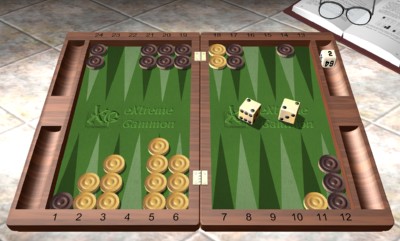Here we’re returning to the theme of the previous post: a late game blitz with a choice of hitting outside or making a point inside. (In this case, making the inside point also has the nice advantage of putting a checker in the air at the same time.) These problems are inherently very difficult, and require looking at all the features of the position before making a decision.

Money game, Black owns the cube, White on roll.
Black to play 2-2.
Let’s start by looking at our goals in a late-game blitz position. Basically, we have four goals. Roughly in order of importance, they are:
(1) Close points in our board.
(2) Hit all the blots we can.
(3) Bring down builders for the remaining open points in our board.
(4) Escape our back checkers.
Note that these are also our goals for an early blitz. The difference between early blitzes and late blitzes is that our opponent’s structure is much stronger in a late blitz, which makes not getting hit and escaping the back checkers a higher priority.
The most common mistake players make in any blitz position is hitting blots instead of closing points in their board. In general, closing home board points is a higher priority than hitting outside blots. (There are plenty of exceptions, of course.) However, hitting more blots is very attractive to most players, and becomes their default choice in blitz positions. Why? Here are the main reasons.
> Hitting blots will win more gammons. True, as long as you eventually close your board.
> Hitting blots will slow our opponent down while he tries to come in from the bar. True. If he has two men on the bar, very few numbers will enter both checkers.
> Hitting blots will give our rear checkers time to escape. Also true. Many players remember all the times they lost a blitz because they couldn’t get their back checkers out. If your opponent is struggling to come in from the bar, he can’t be building a block against you.
These are all true statements, but they don’t tell the whole story, and taken together they can often lead in the wrong direction. Here’s a better idea to keep in mind:
> When you have a choice of good things to do, do the harder thing first. Closing your board is harder than picking up stray blots.
In almost every blitz position, you’ll have only a few rolls to close points. Once you close your board, however, you’ll often get several shots at loose blots while you bring your men around. While a lot of players see hitting blots as a way to buy time, closing points is a much better way to buy time. The longer your opponent dances, the more time you have to escape checkers and pick up the trash.
Now let’s look at our plausible moves:
(1) 3/1* 5/1 11/9. This play makes the ace-point, puts Black on the bar, and brings a third builder to bear on the 4-point.
(2) 3/1* 5/1 18/16. Also makes the ace-point and puts Black on the bar, but now gets a double shot at Black’s other blot. Black, however, now has a few rolls that turn the game around.
(3) 18/14*(2). Picks up the second checker, but doesn’t make another point in the board. Black can now anchor if he rolls an ace.
(4) 18/14* 3/1* 11/9. Puts two checkers up in the air and goes straight for the gammon. A return ace on Black’s part could make things exciting.
From our earlier discussion, it should be clear that White’s first three deuces need to be 3/1* and 5/1, putting Black on the bar against a 5-point board. Playing 18/14*(2) instead gives Black a shot at making an ace-point game, after which White’s winning chances and gammon chances drop off dramatically. To see just how dramatically, imagine that White reaches either a closed board or an ace-point game from this position, with Black’s remaining checkers in their current position. Here are the rollout percentages for the three possible cases:
White has a closed board, one Black checker on bar: 98% wins, 73% gammons.
White has a closed board, two Black checkers on bar: 98% wins, 90% gammons.
Black gets an ace-point game: 85% wins, 33% gammons.
White’s entitled to take small risks to hit the second checker, but preventing the ace-point game is absolutely huge.
So — after making the ace-point, should White play 11/9 or 18/16? Here Black’s strong position provides the clue. In an early blitz, these plays might be close, but with Black’s strong board, 18/16 is too risky, and 11/9 is a better choice.
In the same way, the loose double-hit (Play 4) is also too big. A single ace on Black’s part and the game is up for grabs again.





